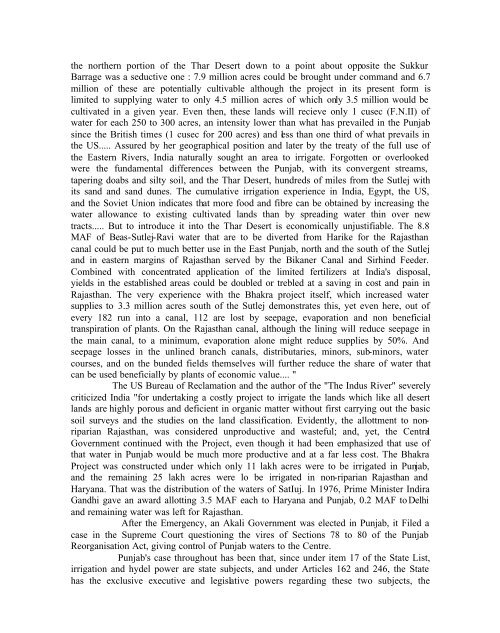Fundamentalism and the Sikh Religious Tradition by T.N. Madan
Fundamentalism and the Sikh Religious Tradition by T.N. Madan
Fundamentalism and the Sikh Religious Tradition by T.N. Madan
Create successful ePaper yourself
Turn your PDF publications into a flip-book with our unique Google optimized e-Paper software.
<strong>the</strong> nor<strong>the</strong>rn portion of <strong>the</strong> Thar Desert down to a point about opposite <strong>the</strong> Sukkur<br />
Barrage was a seductive one : 7.9 million acres could be brought under comm<strong>and</strong> <strong>and</strong> 6.7<br />
million of <strong>the</strong>se are potentially cultivable although <strong>the</strong> project in its present form is<br />
limited to supplying water to only 4.5 million acres of which only 3.5 million would be<br />
cultivated in a given year. Even <strong>the</strong>n, <strong>the</strong>se l<strong>and</strong>s will recieve only 1 cusec (F.N.II) of<br />
water for each 250 to 300 acres, an intensity lower than what has prevailed in <strong>the</strong> Punjab<br />
since <strong>the</strong> British times (1 cusec for 200 acres) <strong>and</strong> less than one third of what prevails in<br />
<strong>the</strong> US..... Assured <strong>by</strong> her geographical position <strong>and</strong> later <strong>by</strong> <strong>the</strong> treaty of <strong>the</strong> full use of<br />
<strong>the</strong> Eastern Rivers, India naturally sought an area to irrigate. Forgotten or overlooked<br />
were <strong>the</strong> fundamental differences between <strong>the</strong> Punjab, with its convergent streams,<br />
tapering doabs <strong>and</strong> silty soil, <strong>and</strong> <strong>the</strong> Thar Desert, hundreds of miles from <strong>the</strong> Sutlej with<br />
its s<strong>and</strong> <strong>and</strong> s<strong>and</strong> dunes. The cumulative irrigation experience in India, Egypt, <strong>the</strong> US,<br />
<strong>and</strong> <strong>the</strong> Soviet Union indicates that more food <strong>and</strong> fibre can be obtained <strong>by</strong> increasing <strong>the</strong><br />
water allowance to existing cultivated l<strong>and</strong>s than <strong>by</strong> spreading water thin over new<br />
tracts..... But to introduce it into <strong>the</strong> Thar Desert is economically unjustifiable. The 8.8<br />
MAF of Beas-Sutlej-Ravi water that are to be diverted from Harike for <strong>the</strong> Rajasthan<br />
canal could be put to much better use in <strong>the</strong> East Punjab, north <strong>and</strong> <strong>the</strong> south of <strong>the</strong> Sutlej<br />
<strong>and</strong> in eastern margins of Rajasthan served <strong>by</strong> <strong>the</strong> Bikaner Canal <strong>and</strong> Sirhind Feeder.<br />
Combined with concentrated application of <strong>the</strong> limited fertilizers at India's disposal,<br />
yields in <strong>the</strong> established areas could be doubled or trebled at a saving in cost <strong>and</strong> pain in<br />
Rajasthan. The very experience with <strong>the</strong> Bhakra project itself, which increased water<br />
supplies to 3.3 million acres south of <strong>the</strong> Sutlej demonstrates this, yet even here, out of<br />
every 182 run into a canal, 112 are lost <strong>by</strong> seepage, evaporation <strong>and</strong> non beneficial<br />
transpiration of plants. On <strong>the</strong> Rajasthan canal, although <strong>the</strong> lining will reduce seepage in<br />
<strong>the</strong> main canal, to a minimum, evaporation alone might reduce supplies <strong>by</strong> 50%. And<br />
seepage losses in <strong>the</strong> unlined branch canals, distributaries, minors, sub-minors, water<br />
courses, <strong>and</strong> on <strong>the</strong> bunded fields <strong>the</strong>mselves will fur<strong>the</strong>r reduce <strong>the</strong> share of water that<br />
can be used beneficially <strong>by</strong> plants of economic value.... "<br />
The US Bureau of Reclamation <strong>and</strong> <strong>the</strong> author of <strong>the</strong> "The Indus River" severely<br />
criticized India "for undertaking a costly project to irrigate <strong>the</strong> l<strong>and</strong>s which like all desert<br />
l<strong>and</strong>s are highly porous <strong>and</strong> deficient in organic matter without first carrying out <strong>the</strong> basic<br />
soil surveys <strong>and</strong> <strong>the</strong> studies on <strong>the</strong> l<strong>and</strong> classification. Evidently, <strong>the</strong> allottment to nonriparian<br />
Rajasthan, was considered unproductive <strong>and</strong> wasteful; <strong>and</strong>, yet, <strong>the</strong> Central<br />
Government continued with <strong>the</strong> Project, even though it had been emphasized that use of<br />
that water in Punjab would be much more productive <strong>and</strong> at a far less cost. The Bhakra<br />
Project was constructed under which only 11 lakh acres were to be irrigated in Punjab,<br />
<strong>and</strong> <strong>the</strong> remaining 25 lakh acres were lo be irrigated in non-riparian Rajasthan <strong>and</strong><br />
Haryana. That was <strong>the</strong> distribution of <strong>the</strong> waters of SatIuj. In 1976, Prime Minister Indira<br />
G<strong>and</strong>hi gave an award allotting 3.5 MAF each to Haryana <strong>and</strong> Punjab, 0.2 MAF to Delhi<br />
<strong>and</strong> remaining water was left for Rajasthan.<br />
After <strong>the</strong> Emergency, an Akali Government was elected in Punjab, it Filed a<br />
case in <strong>the</strong> Supreme Court questioning <strong>the</strong> vires of Sections 78 to 80 of <strong>the</strong> Punjab<br />
Reorganisation Act, giving control of Punjab waters to <strong>the</strong> Centre.<br />
Punjab's case throughout has been that, since under item 17 of <strong>the</strong> State List,<br />
irrigation <strong>and</strong> hydel power are state subjects, <strong>and</strong> under Articles 162 <strong>and</strong> 246, <strong>the</strong> State<br />
has <strong>the</strong> exclusive executive <strong>and</strong> legislative powers regarding <strong>the</strong>se two subjects, <strong>the</strong>
















